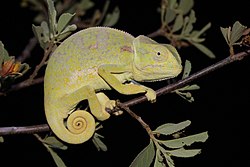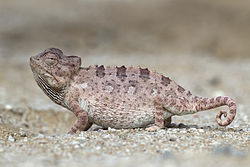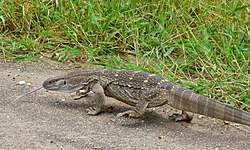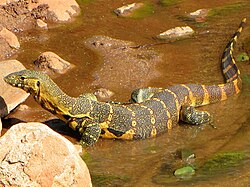| Common name | Binomial name | Length | Global status | Global trend | Distribution | Image |
|---|
| Jameson's mamba | Dendroaspis jamesoni | ~250 cm (98 in) | Least Concern |  | Found in Central and West Africa, including parts of northern Angola; inhabits forested and woodland areas, often arboreal but also active on the ground. |  |
| Black mamba | Dendroaspis polylepis | ~450 cm (180 in) | Least Concern |  | Widely distributed across sub-Saharan Africa, including Angola; prefers savannahs, open woodlands, and rocky areas. |  |
| Günther's garter snake | Elapsoidea guentherii | ~50 cm (20 in) | Least concern | ? | Found in Angola, southern DRC, and Zambia; fossorial and inhabits dry savannahs. | |
| Angolan garter snake | Elapsoidea semiannulata | ~60 cm (24 in) | Least concern | ? | Found in Angola, Congo, DRC, and parts of Gabon; found in forests and savannas. | |
| Anchieta's cobra | Naja anchietae | ~200 cm (79 in) | Least Concern |  | Found in Angola, Botswana, Namibia, and Zambia; inhabits dry savannahs. | |
| Banded water cobra | Naja annulata | ~275 cm (108 in) | Least Concern | ? | Found in Central and East Africa, including the Congo River basin; highly aquatic and inhabits rivers, lakes, and swamps. |  |
| Forest cobra | Naja melanoleuca | ~300 cm (120 in) | Least Concern |  | Widely distributed across sub-Saharan forests, including Angola; found in forests, woodlands, and sometimes human settlements. |  |
| Mozambique spitting cobra | Naja mossambica | ~150 cm (59 in) | Least Concern | ? | Found in southern Africa, including Angola; inhabits forests, savannahs, scrubland, and artificial terrain. |  |
| Many-banded snake | Naja multifasciata | ~200 cm (79 in) | Least Concern |  | Found in tropical rainforests of Central Africa, including very northern parts of Angola. | |
| Western barred spitting cobra | Naja nigricincta | ~200 cm (79 in) | Least Concern |  | Found in southwestern Angola and Namibia; inhabits dry savannahs, shrubland, and rocky areas. |  |
| Black-necked spitting cobra | Naja nigricollis | ~200 cm (79 in) | Least Concern | ? | Found throughout sub-Saharan Africa, including Angola; inhabits savannahs, woodlands, and urban areas. |  |
| Brown forest cobra | Naja subfulva | ~300 cm (120 in) | Least Concern |  | Found in forests and woodland savannahs of Central and East Africa, including Angola; found in forests, savannas, wetlands, and urban areas. |  |
| Goldie's tree cobra | Pseudohaje goldii | ~250 cm (98 in) | Least Concern | ? | Found in forests of Central and West Africa, including Angola; found in forests. |  |























































